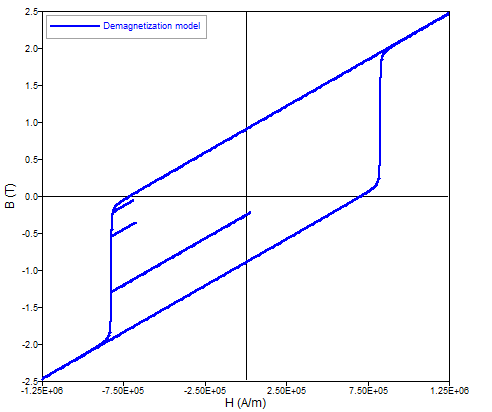Since version 2026, Flux 3D and Flux PEEC are no longer available.
Please use SimLab to create a new 3D project or to import an existing Flux 3D project.
Please use SimLab to create a new PEEC project (not possible to import an existing Flux PEEC project).
/!\ Documentation updates are in progress – some mentions of 3D may still appear.
Magnet (unidirectional): demagnetization curve (HcB, HcJ and Br)
Presentation
This model (Nonlinear magnet described by HcB, HcJ and Br module) defines a nonlinear B(H) dependence. Non-linearity is considered in the direction of magnetization whereas the model's behavior is linear in the transversal directions.
This magnet model is noted as unidirectional because the mathematical model and the direction of magnetization are dissociated (About orientation of magnets). The mathematical model defines the demagnetization curve, while the direction of magnetization is defined by the orientation in the region (Orient materials in massive regions: volume (3D) / face (2D)).
Furthermore, this model can consider demagnetization during solving, wherever the curve knee is, if the corresponding option is selected (Demagnetization during solving).
Mathematical model
The mathematical formula used in Flux for the demagnetization curve is:
This formula is better clarified if we split it into the basic parts.
and
where:
- μ0 is the permeability of vacuum, μ0 = 4 π 10-7 H/m
- Br is the remanent flux density (T)
- HcJ is the intrinsic coercivity (A/m)
- Js is the saturation magnetic polarization (T)
Js is automatically computed by Flux when the magnetic field intensity H in the above mathematical formula B(H) is replaced by the normal coercivity -HcB value.
The shape of the B(H) and the J(H) dependence in the direction of magnetization are given in the figure below:
In transversal directions one can write:
where μr ┴ is the transversal relative permeability.
Direction of magnetization
The various possibilities provided to the user are the same ones as those presented in § Magnet (unidirectional): linear approximation.
Demagnetization during solving
With this non-linear model, it is also possible to consider the demagnetization during solving (i.e. the irreversible degradation of a magnet's remanent magnetic flux density due to its interaction with a demagnetizing field) by checking the specific option that is provided during the material creation. This demagnetization model is based on a static Preisach approach and may apply in all quadrants of the magnet B(H) characteristic. The following additional remarks apply:
- Available for 2D and 3D in transient magnetic application
- In projects containing a magnet material with this option active, it is advisable to set the application to perform an initialization through a static calculation ()
- This model does not take in account temperature variations

- Delete the results;
- Go in and select: Initialization by static calculation;
- Create a new material Nonlinear magnet described by HcB, HcJ and Br module;
- Check the option Taking into account demagnetization during solving;
- Assign the material to the regions representing the magnets in the project;
- Go to to define the direction of magnetization of the magnet;
- Solve the scenario.
- Select the desired time step;
- Create a new Arrows plot, then select the magnet as support;
- Then, in the formula editor, click on button Br Magnet (available in the
Magnetic Volume region tab) or type BrMagnet (without a space) in the
formula field.Note: In the formula editor, a related button Br is available and the user could also type the corresponding formula Br in the formula field. Remark that these recover the original remanent magnetic flux density stored in the material description, and not the remanent magnetic flux density modified by demagnetization effects at a given time step represented by BrMagnet.
In Flux, hard magnetic materials may be imported, exported and reused with the help of dedicated data exchange tools. These tools are notably useful when used in conjunction with magnets described by the B(H) property of type Nonlinear magnet described by HcB, HcJ and Br module, with the option for consideration of demagnetization during resolution. For a complete discussion on this topic, refer to the following documentation chapter: Import, export and reuse magnets.
Example of results
